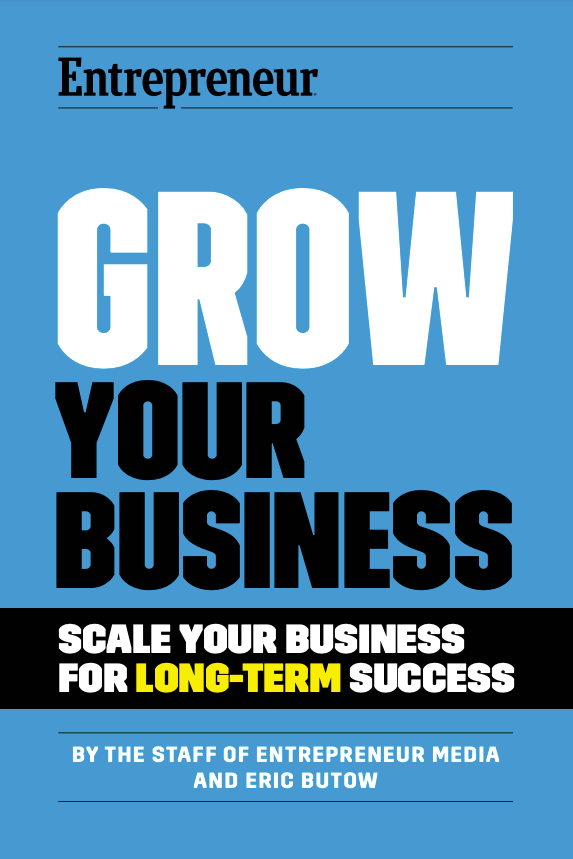Want to Sell More Products, Get More Customers and Make More Money? Ask Yourself These 4 Questions. Learn how to strategically expand your business with this plan from the new book "Grow Your Business."
By Entrepreneur Staff •
The following is an excerpt from Grow Your Business: Scaling Your Business for Long-Term Success by the staff of Entrepreneur Media and Eric Butow, on sale now.
You've probably heard this saying since you were very young: Don't put all your eggs in one basket. It's trite, but it persists because diversifying often leads to success, especially for products, customers, and marketing. If you make only one product, have only one huge customer, or use only one method of marketing, you're putting yourself in danger.
This can be confusing because you've probably also heard that you have to focus squarely on one niche. How do you reconcile these two seemingly opposing approaches? As with many things in life, the answer lies somewhere in the middle. You need to start somewhere, so start with one product or service and one market.
You have to make sure that the first product or service is excellent and sells well before you add more. For example, Apple helped establish the home computing market with the Apple II in 1977, but it made iterations of that product with the Apple II Plus and the Apple IIe before introducing the Macintosh in 1984. It's just as important not to use the "throw everything at the wall and see what sticks" approach because then your focus becomes scattered and you can't develop or support your products. Apple fell into that trap in the 1990s, when it had so many Macintosh models that it was hard to keep track of them all. At the same time the company was developing other products, such as the Newton handheld computer. When Steve Jobs returned to Apple in 1997, he cut down the hardware line to just four devices: the iMac and PowerMac desktops and the iBook and PowerBook laptops. Once those were selling reasonably well, Jobs turned to developing new products, such as the iPod.
Grow Your Business: Scaling Your Business for Long-Term Success is available now at Entrepreneur Bookstore | Amazon | Barnes and Noble
Diversify Your Products, Services, or Both
Depending on how your product or service is selling, it might be time to look at adding to your company's repertoire. With a product, you may feel compelled to create a new one for several reasons. Suppose that tracking your sales (you are doing that, aren't you?) shows that sales of the product are slumping. Customers may want a new product that is more useful or exciting. The same is true for services. You might want to offer a new one, either to complement an existing product or service, to replace one that's not selling as well, or to enter a new market segment. Before you decide to add a new product or service or replace the one that you're currently selling, take these four steps:
- Determine the specific needs of customers in each of the markets you sell to.
- Identify the products or services that will be attractive to your customers.
- Create a unique value proposition and determine how you'll position the product
- Determine the sales and distribution channels you'll use for your market segments.
Also talk with current and prospective customers, your marketing team (or partners), and any distributors to find out how they think your company can help people with new products or services.
Diversify Your Customers
Speaking of customers, one thing to determine during your exploration is whether your current customer base is the best one for you. For example, you may find that your current market segment serves a customer base that looks very much like the one you've been trying to reach all along. Or you may look at what your competitors are doing and notice that they aren't serving a particular market niche very well, if at all—but you think you can. No matter if you're a small or large company, you can fall into the same trap: having one large customer either as your only customer or as one that provides a disproportionately large amount of your revenue. If you have a customer like that, no doubt you have nightmares about them leaving you. You're convinced that you need to expand with more products, services, and/or markets to find more customers and stabilize your company. You've probably guessed the next step: Identify genuine problems that your company can solve, not just to keep current customers in the fold, but also to serve potential customers.
Grow Your Business: Scaling Your Business for Long-Term Success is available now at Entrepreneur Bookstore | Amazon | Barnes and Noble
Here are four questions to ask yourself when you want to expand:
1. Is the timing right?
As with comedy, timing is everything. Find out if your product or service is something your clients need right now. If they don't, find out what problems they are having and see if your company can provide solutions.
2. Is your company well-positioned to make a new product or service work for your clients?
In the summer of 2022, the watchmaker Omega worked with Swatch to offer the MoonSwatch, which was a far less expensive version of its Moonwatch (so named because it was worn by U.S. astronauts on the moon). The MoonSwatch was offered exclusively in Swatch stores and were so popular that the original supply of watches ran out in hours, store employees around the U.S. were overwhelmed, and Swatch had to tell people who waited at stores for hours that the watch wasn't available. The company had to deal with a lot of negative online reviews from frustrated people who had waited for hours in line at Swatch stores hoping to buy a watch. The moral of this story is to make sure you have the product, the people, and the tools you need to serve your customers.
3. Do you have the skills to succeed?
You not only need to know your customers' needs very well, but you also need to have the skills to produce your product or service and deliver it.
4. Will moving fast help you win?
You need to know what your competition is doing throughout the development process. If your competitors aren't moving much, if at all, it may make sense to take your time and produce a richer solution. If they are moving fast, you need to release the product or service only with the features your clients absolutely need. You can add all the extra features you planned in future updates
Related: How to Create a Growth Plan for Your Business in 6 Simple Steps
Beware of Feature Creep
This is where you constantly want to make changes and additions to a product in development, can be fatal when you're dealing with one or more competitors, so make sure it doesn't happen. You can prevent it by being strict about which features you need to ship because there will be times when developers, sales, or marketing want you to add something they feel is vital. As long as you show customers that you're giving them what they need and you're working constantly to improve it, they'll be patient with your solution as you grow.
For more growth strategies, pickup Grow Your Business: Scaling Your Business available now at Entrepreneur Bookstore | Amazon | Barnes and Noble











